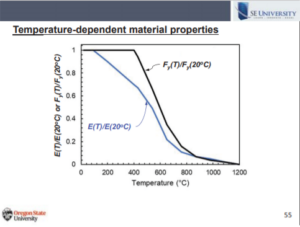Are you familiar with the significant changes and common failure modes that occur in a steel framed structure during a fire? For over a century, engineers have been using a prescriptive approach to protect steel structures and their occupants from a fire event. The International Building Code also permits the application of performance-based structural fire design to evaluate structural systems during a fire in a similar manner as other design loads are treated. Could any of your projects benefit from a structural fire engineering design rather than the typical prescribed fire protection?
In the June 2021 SE University session, Erica Fischer, PhD, PE, from Oregon State University, presented Structural Fire Protection. Erica explained the difference between a prescriptive fire protection design and structural fire engineering. Erica qualitatively showed how steel strength and stiffness change with increasing temperature and how boundary conditions for beams and columns can change during a fire event. She also presented a case study showing the benefits of employing fire engineering on a steel framed structure.
Structural fire engineering becomes a complex endeavor because of the temperature-dependent material properties and the potentially changing boundary conditions throughout a fire. As you might expect, as the temperature increases, both the yield stress and ultimate stress are decreasing and the elastic modulus is decreasing, however they are not decreasing uniformly. Erica included the following slide which shows the complexity of these changing mechanical material properties. As you can see, the yield stress remains constant until about 400 degrees, but the stiffness decreases at a much lower temperature and they are not decreasing linearly.
Additionally, not all steel components have the same degradation patterns of material properties. Steel bolts, for example, respond differently than mild steel to thermal increases. Thus, predicting the behavior of connections can be very complex and the controlling failure modes at elevated temperatures will be different than those at ambient temperature. To hear Erica explain the changes to boundary conditions throughout a fire, watch this short 3 minute video:
During her presentation, Erica suggested engineers refer to ASCE’s Structural Fire Engineering MOP 138 book to learn more about performance-based structural fire engineering. This book is available on ASCE’s website for purchase as an e-book or in print. This reference provides guidance on calculated design of a structure to withstand the thermal load effects of fire, including performance objectives and analysis techniques to quantify the structural response to thermal increases.

